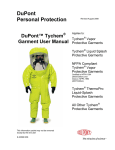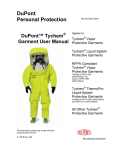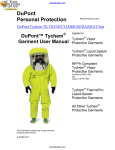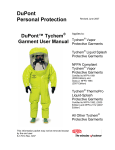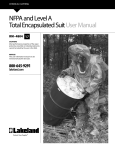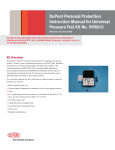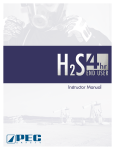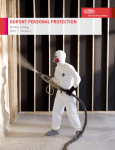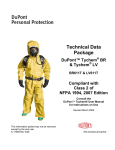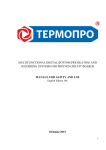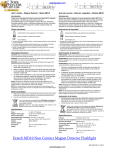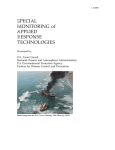Download Tychem User Manual
Transcript
actoolsupply.com DuPont Personal Protection Revised February 2013 DuPont RF600T XL Tychem Reflector Vapor HAZMAT Suit ® DuPont™ Tychem Garment User Manual Applies to: Tychem® Vapor Protective Garments Tychem® Liquid Splash Protective Garments NFPA Compliant Tychem® Vapor Protective Garments Certified to NFPA 1991 and Class 2, NFPA 1994 Tychem® ThermoPro Liquid-Splash Protective Garments All Other Tychem® Protective Garments This information packet may not be removed except by the end user K-20569 02/13 actoolsupply.com actoolsupply.com Table of Contents Safety Considerations .................................................................... 3 Wearer Qualifications ..................................................................... 3 Required and Additional Equipment .............................................. 3 Garment Maintenance Schedule .................................................... 5 Closure Lubricants.......................................................................... 6 Garment Inspection......................................................................... 6 Pressure Testing Level A, Vapor-Protective Garments ................ 7 Repairing Garment .......................................................................... 7 Glove Replacement ......................................................................... 8 Duration of Recommended Use ..................................................... 8 Storage Conditions ......................................................................... 8 Visor Antifog Procedures ............................................................... 8 Marking Suggestions and Restrictions ......................................... 8 Suggested Undergarments............................................................. 8 Sizing Considerations ..................................................................... 9 Donning the Garment ...................................................................... 9 Doffing the Garment...................................................................... 11 Decontamination and Cleaning .................................................... 12 Garment Retirement Considerations ........................................... 13 Disposal ......................................................................................... 13 Usage Guidance ............................................................................ 14 Warnings ........................................................................................ 17 Your Responsibility as a User ...................................................... 18 Warranty & Disclaimers ................................................................ 22 DuPont™ Tychem® Encapsulating Garment Sizing.................... 24 DuPont™ Tychem® Non-Encapsulating Garment Sizing............ 24 Garment Inspection & Test Log ................................................... 25 Terms shown in italics are listed in the glossary. 2 actoolsupply.com actoolsupply.com DuPont™ Tychem° Garment User Manual Safety Considerations IMMEDIATELY STOP WORK IF PERSONAL PROTECTIVE EQUIPMENT (PPE) FAILS. If any item of the personal protective equipment fails during use, immediately cease work activity, safely remove the PPE, determine the cause of the PPE failure and re-evaluate the selection and use of the PPE for that task. Be sure to read, understand and follow the information in this manual and all applicable federal, state and local occupation safety and health statutes. Serious injury or death may occur from improper use of these garments. Proper use must be consistent with NFPA 1500, Standard on Fire Department Occupational Safety and Health Program and NFPA 2113, Standard on Selection, Care, Use and Maintenance of Flame-Resistant Garments for Protection of Industrial Personnel Against Flash Fire. Additionally, use these garments in accordance with applicable personal protective equipment regulations, which in the United States is 29 CFR 1910.132. For users of these garments outside the United States, consult national or other applicable personal protective equipment laws and regulations. ® While wearing any Tychem garment, ® including Tychem ThermoPro, do not knowingly enter an environment in which the concentration of flammable gas is within flammable or explosive limits. Immediately retreat if you determine that you are in a potentially flammable or explosive environment while wearing any ® ® Tychem garments, including Tychem ThermoPro. ® immediately leave the contaminated area, undergo field decontamination, and remove (doff) the garment: Fever Difficulty breathing Nausea Excessive Tiredness Dizziness Numbness Any unusual odor or taste Eye or skin irritation Narrowing or dimming of vision Claustrophobia Loss of balance or orientation Wearer Qualifications Do not wear these garments unless you are properly trained in their usage. You must be in good physical condition to wear these garments. Consult a physician before donning one of these garments to ensure you are capable of wearing these garments under the expected work conditions and environment. Required and Additional Equipment ® To help protect you while wearing Tychem garment and to ensure that the garment performs as intended, wear, at a minimum, several additional items of personal protective equipment. Encapsulating garments completely cover you from head to toe, including all respiratory equipment (except for external air supply lines). Encapsulating garments require supplied fresh air; there is not enough fresh air inside encapsulating garments for you to breathe. By design, the replenishment of fresh air is restricted within an encapsulating garment. Tychem garments will not protect you in all situations and environments or protect you from all hazardous materials. You must be a trained and qualified safety professional to select chemical protective clothing. It is your responsibility as a user of this garment to determine the level of exposure and the proper personal protective equipment needed. Most performance properties cannot be tested by the users in the field. ® Refer to the DuPont™ Tychem Permeation Guide for chemicals specific to your situation. Encapsulating garments that pass the inflation test described in ASTM F 1052, Standard Test Method for Pressure Testing Vapor Protective Ensembles are considered Level A; encapsulating garments that are not designed to pass this test are considered Level B. If any of the following symptoms develop ® while you are wearing a Tychem garment, NOTE: YOU MUST WEAR AN OPENCIRCUIT SELF-CONTAINED BREATHING 3 actoolsupply.com actoolsupply.com DuPont™ Tychem° Garment User Manual APPARATUS OR AIR-LINE SUPPLIED RESPIRATOR WITH ALL ENCAPSULATING GARMENTS. harnesses specified in the BR611T/LV611T Technical Data Package. OVERCOVERS At a minimum, wear the following additional personal protective equipment with an encapsulating and non-encapsulating ® Tychem garment: RESPIRATORS You must wear a full face, supplied air respirator with encapsulating (Level A or ® Level B) Tychem garments. • • An open circuit, self-contained breathing apparatus (SCBA) which is also certified as compliant with NFPA 1981 Standard on Open-Circuit Self-Contained Breathing Apparatus for Fire Service, or An external, breathing air-quality, air-line system with garment pass-through and escape bottle. Do not wear a closed-circuit (rebreathertype), SCBA with Level A or encapsulating Level B garments. The oxygen concentration inside the suit will rise above normal levels. The final oxygen concentration will depend on the type of closed-circuit respirator you are wearing, your level of exertion and the how long you wear the garment. You cannot wear an air-purifying respirator (APR) inside a Level A garment or inside a Level B encapsulating garments or under separate hoods that extend below the clavicle. A powered, air-purifying respirator (PAPR) will not work inside an encapsulating garment. (If you breach the garment to expose the PAPR filters to the outside, the garment is no longer considered to be encapsulating.) You can wear a PAPR under a separate hood, if the configuration provides adequate ventilation at the intake of the unit and if the unit is adequately protected from contamination. Note: Do not wear the NFPA 1994 Certified ® Tychem BR611T and LV611T with a negative pressure, air-purifying respirator. These garments are only compliant when worn with the SCBA facepieces and ® NFPA 1991 compliant Tychem TK and ® ® Tychem Responder ensembles must be worn with a separate overcover to achieve abrasion resistance, puncture resistance, and protection from direct flame impingement requirements of that standard. Consider wearing an overcover over other encapsulating garments when there is a risk of abrasion, puncture, cut, tear or direct flame impingement to the garment FOOTWEAR You must wear separate, user-supplied, protective footwear. The socks attached to ® some Tychem garments must be worn inside protective outer footwear. These socks are not suitable as outer footwear. You must wear the separate, user-supplied protective footwear specified in the Technical Data Package which accompanies your NFPA 1991, NFPA 1992 or NFPA 1994 compliant garments. Do not rely on adhesive tape around the top of the boot to prevent liquid pooling inside your boot when wearing a garment with socks and no boot top covers. Adhesive tape does not provide a leak-proof seal. Taping is only used to hold the leg of the garment in position with regards to the boot. If a leak-proof seal is required, then select garments with attached socks and boot top covers. When wearing a garment with an elastic or hemmed ankle opening, you must wear the leg of the garment over the top of the chemical protective boot to reduce the potential of liquid pooling in the boot GLOVES Chemical protective gloves are attached to your NFPA 1991 and NFPA 1994 compliant ® Tychem garments. NFPA 1991 compliant garments are available with a 3-layer glove system or with the 2-layer St. Gobain ONEGloveۙ™. NFPA 1994 compliant garments user a 2layer glove system. Removal of one of 4 actoolsupply.com actoolsupply.com DuPont™ Tychem° Garment User Manual these glove layers may compromise chemical barrier or glove durability. If gloves are not attached to the garment, then wear your chemical protective gloves, with the sleeve of the garment over the gauntlet of the glove. OTHER PERSONAL PROTECTIVE EQUIPMENT You may need other personal protective equipment based on the hazard assessment and PPE selection made by a trained and experienced safety professional. Adhesive taping of the glove to sleeve interface does not provide a leak-proof seal. Taping is only used to hold the sleeve in position over the glove gauntlet. For the most leak resistant seal between glove and sleeve, select a garment with attached gloves. It is your responsibility to determine if you need separate head protection. For example, you may require hearing protection due to high levels of external noise or high noise levels generated by supplied air systems. The separate, cut resistant outer gloves that come with your NFPA 1991 are required to meet the cut performance requirements of that standard. With other garments, consider similar, cut-resistant outer gloves when you need a high level of cut protection. You may require additional protective equipment to deal with hazards created by, but no limited to, the following conditions: When wearing Tychem® ThermoPro, wear outer gloves suitable for thermal protection, such as those compliant with NFPA 1971 or NFPA 1951. For additional chemical protection, chemical barrier gloves, such as Ansell Barrier® or North Silver Shield® can be worn under the thermal protective gloves and over inner cotton or knit KEVLAR® gloves. - It is your responsibility to verify that the gloves will provide adequate physical protection and chemical barrier. Flammable or Explosive Environment Decontamination Extreme Heat (Heat Stress) Extreme Cold (Hypothermia) Asphyxiating Atmosphere Physical Hazards (Sharps, Puncture, Rough Surfaces, Falling Debris) Slipping or falling Visibility - of wearer & by wearer Communications Garment Maintenance Schedule Interval Work to Be Performed Upon Receipt Check by Wearer After each use Once per year X X X Inflation Test (Level A) X X Exhaust Valve Diaphragm Inspection (Level A) X X X Exhaust Valve Diaphragm Replacement (Level A) Closure Lubrication Every 2 years X Cleaning Garment Inspection Prior to Use X As required 5 actoolsupply.com actoolsupply.com DuPont™ Tychem° Garment User Manual Closure Lubricants 1. Lay the garment on a clean, smooth surface. You can lubricate a zipper or closure that is difficult to operate. Apply paraffin wax or YKK Zippy Cool Lubricant lightly on the teeth of the closure. After lubrication, close and open the zipper a number of times to ensure smooth function and to remove excess lubricant. NOTE: EXCESSIVE FORCE OR IMPROPER TECHNIQUE CAN DAMAGE THE GAS-TIGHT ZIPPERS IN LEVEL A SUITS. When opening or closing the zipper, use one hand to hold the zipper assembly near the slider while pulling the slider in a direction that is parallel, close to and along the line of the zipper assembly. Excessive force and not pulling the slider in line with the zipper can lead to permanent damage to the zipper. Garment Inspection (applies to all categories of Tychem garments) ® ® Tychem Garment Inspection ® You must inspect all Tychem garments at the following times: 1. Immediately upon receipt from supplier 2. Before it is placed in service to be worn. 3. After a garment is worn and before the garment is placed in service to be worn again. Do not use contaminated, damaged or altered garments. 4. Annually. Inspection determines if the performance of the garment has been compromised. Perform the first inspection as soon as you receive the garment. This ensures that no damage occurred during shipping. Inspect your garment before wearing, especially if the garment has been worn before. Do not use contaminated, damaged or altered ® Tychem garments. Inspect stored garments once a year. Follow these steps with inspecting garments: 2. Use a flashlight inside and examine the outside of the garment for holes, cuts, or tears. Note: Apparent stitch holes covered by seam sealing tape does not constitute a defect. 3. Examine the seam tape for lifts or inadequate seal. 4. Examine the garment material and seams for signs of damage. Fabrics and seams sometimes have visual blemishes that do not affect barrier performance. Such blemishes can include dullness or white frosted areas adjacent to the seam tape. A breach or rupture of the barrier film is cause for rejection. 5. Tincture of Iodine is used to confirm a physical breach. Apply Tincture of Iodine to the suspect area and wipe off the excess with a dry towel. If a dark brown stain remains, the barrier layer has been breached and the garment must be rejected. Areas immediately adjacent to the seam tape may take a slight yellow stain as a result of heat exposure during manufacture. This slight yellow stain is not an indication of a breach. The edges of the seam tape may also develop a thin, but prominent staining of the exposed edge. This is also not an indication of a defect. 6. Examine the visor (if present) for a tight seal and make sure the visor offers clear vision. 7. Examine the garment air distribution system (if present) to make sure that it is connected properly and appears to be in working order. 8. Examine the garment gloves (if present) to make sure they are in good working order. 9. Examine the interface between the gloves and the garment if gloves are attached to the garment. Pull on the gloves to make sure that they are firmly attached to the suits. NOTE: You can potentially damage the gloves by pulling with excessive force. 6 actoolsupply.com actoolsupply.com 10. Examine the interface between the socks and the garment if the socks are attached to the garment. Conduct inflation tests according to ASTM F1052, “Standard Test Method for Pressure Testing Vapor Protective Ensembles”. A 11. Examine the garment zipper and zipper cover to make sure they are in good working order. Lubricate the zipper using a small amount of paraffin wax or lubricant supplied by the closure manufacturer. 12. Examine all garment snaps, closures, adjustment straps, pass-thrus and options to make sure they are not obstructed and are in good working order. 13. Examine garment-warning label(s) to make sure they are firmly attached and can be read easily. 14. Subject Level A garments to an inflation test during each garment inspection. As part of the inflation test, the exhaust valve diaphragms must be removed. Replace these exhaust valve diaphragms every two years from the date of suit manufacture. Outside this schedule visually inspect the exhaust valve diaphragms. Use a magnifying glass to look for cracks or deterioration. Replace damaged or deteriorated diaphragms. Instructions for replacing the exhaust valve diaphragm can be found in the DuPont Personal Protection Instruction Manual for Universal Pressure Test Kit. Auer Exhaust Pirelli Exhaust Valve Valve copy of the standard may be obtained for a fee from ASTM (www.ASTM.org) or by calling (610) 832-9585. Read, understand and follow the instructions in the Instruction Manual for the Universal Pressure Test Kit when inflation testing ® Tychem Level A garments. You can obtain a copy of these instructions by calling DuPont Personal Protection Customer Service. Record the results of each inflation test with the log sheet provided with your garment. You can also find a blank log at the end of this document. The diaphragm in each exhaust valve must be replaced by the end user every two years from date of manufacture. Instructions for replacing the exhaust valve diaphragm can be found in the DuPont Personal Protection Instruction Manual for Universal Pressure Test Kit. Pressure Testing Level A, Vapor-Protective Garments The air-inflation test evaluates the integrity ® of the Tychem Level A, vapor-protective garments. ® DuPont manufactured Tychem TK, ® ® Tychem BR and Tychem LV Level A garments are equipped with Auer exhaust valves. Auer valves are fitted with a flexible outer “snorkel” cover that opens at right angles to the throat of the exhaust valve. ® ® ® Tychem Responder and Tychem ® Reflector garments are fitted with Pirelli valves. These valves are fitted with a rigid outer cover that is perforated with small holes. Properly installed Auer exhaust valve diaphragm (outer cover of exhaust valve not shown) Properly installed Pirelli exhaust valve diaphragm (outer cover of exhaust valve not shown) Repairing Garment 7 actoolsupply.com actoolsupply.com Do not use a damaged, altered or contaminated garment. If an uncontaminated or unaltered garment fails a visual inspection or pressure test, contact your safety equipment distributor to determine if the garment can be returned for inspection or repair. Note: Charges may be incurred. Retire and label “For Training Use Only” or discard after mutilation, uncontaminated garments that do not pass a visual inspection. This includes Level A garments that do not pass the inflation test. Contaminated garments will not be accepted for repair. Do not send a garment that is discolored or smells. With each returned garment, you must provide the garment testing log and a declaration that the garment has not been exposed to chemicals or to biological pathogens. DO NOT ATTEMPT TO RETURN A GARMENT WITHOUT AUTHORIZATION FROM DUPONT PERSONAL PROTECTION CUSTOMER SERVICE. Store Tychem garments in a cool, dark, dry location free of dirt and insects. Sunlight, ozone, high temperatures (>120° F), vehicle exhaust fumes, compression under heavy weights and sharp edges or projections are some conditions known to degrade the materials in these ensembles. Glove Replacement Storage Conditions ® ® Store Tychem garments in boxes, in bags or on hangers. Never step on chemical protective garments. Never place or store heavy objects on top of chemical garments. Visor Antifog Procedures Contact DuPont Personal Protection to determine if the attached gloves on your garment can be replaced. Duration of Recommended Use ® Tychem garments may be used as long as they pass a full visual inspection. In addition to the visual inspection, Level A garments must pass the ASTM F1052 inflation test. ® All DuPont™ Tychem chemical protective garments may contain materials, including gloves and closures for which there is no specific storage life data available. It is suggested that garments be labeled and retired to “Training Use Only” after 5 years after receipt by the purchaser. The diaphragm in each exhaust valve must be replaced by the end user every two years from date of manufacture. Instructions for replacing the exhaust valve diaphragm can be found in the DuPont Personal Protection Instruction Manual for Universal Pressure Test Kit. Antifog treatments can be applied to the ® interior of Tychem garment visors. Use antifog wipes or sprays suggested by DuPont Personal Protection. 1. Apply the antifog/anti-static cleaner to a clean, dry cloth or open the prepackaged antifog wipe and unfold it. 2. Apply the antifog solution evenly to interior visor surface. 3. Buff to a clear finish with soft cloth. Marking Suggestions and Restrictions ® Tychem garments can be marked with a permanent, felt tip marker. Suggested Undergarments Thick, bulky clothing worn underneath ® Tychem garments will affect the fit of the garment and limit the movement of the wearer. You may require a larger size ® Tychem garment. 8 actoolsupply.com actoolsupply.com ® With the exception of Tychem ThermoPro garments, you will not reduce your potential for burn injury by wearing garments made of ® NOMEX or any other flame-resistant fabric, ® under any other Tychem garment. ® Tychem garments will burn and possibly melt when exposed to a fire. Only wear non-melting materials under ® Tychem ThermoPro garments. These ® could include NOMEX or other non-melting fabrics such as wool, cotton, silk and rayon. Sizing Considerations ® Verify the size of your Tychem garment before actual use. Start with the sizing chart found at the end of this document. Verify the size selection with a garment of the recommended size and style you intend to use. Don the garment and perform a series of exercises to simulate your movements under actual work conditions. A garment one size larger or smaller than recommended in the table may be required. However, a garment that is too large is as unsatisfactory as a garment that is too small. These sizing tests must include outer boots, head protection and other accessories the wearer may carry during actual use. Such exercises may include: Donning the Garment You can obtain a donning/doffing training video (H-96428) or DVD (H-96425) by calling DuPont Personal Protection Customer Service. Have a second person present when donning or doffing your chemical protective ensemble. If you are outdoors, use a ground cloth to avoid damaging your garment. Use a stable chair, bench or stool which is free of sharp edges. Encapsulating Level A and B Garments 1. Conduct a visual inspection of the garment before you begin donning: - garment must be free of discoloration or physical damage - inner gloves must be fully inserted into outer gloves - Inside and outside of exhaust valves must be free of caps, plugs or foam padding. - read the SCBA gauge 2. Remove all jewelry and personal items (pens, key rings, badges, pagers, knife cases, etc.) that might damage the garment. - pick up a box, carry it and set the box down in a separate location 3. Check function of respirator and place near donning location. - pick up a wrench from the ground 4. Visually check size and condition of outer boots and place them nearby. - open the garment closure 5. Open garment closure completely. - climb up and down stairs and ladder 6. Read garment size label to assure proper fit. - adjust respirator facepiece straps 7. Apply antifog to inside of visor. - remove the SCBA without dislodging the full face respirator 8. Remove your shoes. If the garment has socks, these socks are worn inside additional outer chemical boots. These socks do not have adequate durability or slip resistance to be worn as the outer footwear covering. - remove and refit full face respirator - send and receive radio transmissions - communicate with co-worker wearing the same type of garment and additional equipment - for encapsulating garments, remove hand, wipe faceshield and adjust regulator on facepiece. 9. While sitting, insert your feet into the garment legs and down into socks, if so equipped. Stretch out your legs to maximum extension while pulling garment up around hips. If the garment is fitted with boot top covers, pull boot top covers up and don outer boots. 9 actoolsupply.com actoolsupply.com Then pull the boot top covers down over the boots as far as possible. 10. While standing, connect and adjust the garment waist belt (if equipped) until comfortably snug. 1. Conduct a visual inspection of the garment before you begin donning: - garment must be free of discoloration, alterations or physical damage - inner gloves must be fully inserted into outer gloves 11. While standing, with garment at waist level, don your respirator back piece. 12. Don your respirator facepiece and check its function. To conserve SCBA air supply, disconnect the air supply from the facepiece, as long as the closure is open and you have access to fresh air. In the case of an airline breathing system, complete all other connections and adjustments. 13. Don protective headgear and communication equipment. 14. Connect the respirator facepiece to the air supply and make sure the respirator is functioning properly. 15. Place one hand in the sleeve and pull the garment sleeve to your shoulder. Make sure your hand is securely inside the glove, if attached. 16. Place your other hand in the sleeve and into the glove, if attached, and pull the garment over that shoulder. 17. If gloves are not attached to the garment, then don your gloves. Pull the sleeves of the garment over the gauntlet of the gloves. Do not rely upon taping to provide a liquid-tight seal. Only use tape to hold the sleeve in position over the glove gauntlet. If a leak-proof seal between the glove and sleeve is required, then wear garment with attached gloves. 18. Pull the garment over the respirator backpack making sure nothing will constrict or hamper airflow. 19. Have your assistant slowly close the zipper. Have your assistant carefully close and secure the flaps over the zipper. Donning Non-Encapsulating Garments These instructions apply to all non® encapsulating DuPont Tychem ensembles except for NFPA 1994, Class 2 Compliant BR611T & LV611T ensembles. Donning/Doffing Instructions for BR611T & LV611T ensembles are found in the Technical Data Package provided with each of those garments. 2. Remove all jewelry and personal items (pens, key rings, badges, pagers, knife cases, etc.) that might damage the garment. 3. Check function of respirator and place nearby donning location. 4. Visually check size and condition of outer boots and place nearby. 5. Open the garment closure completely. 6. Read the garment size label to assure proper fit. 7. Apply antifog to inside of visor, if present. 8. Remove your shoes. If the garment has attached socks, these socks are worn inside outer chemical boots. These socks do not have adequate durability or slip resistance to be worn as the outer footwear covering. 9. While sitting, insert your feet into the garment legs and down into socks, if so equipped. Stretch your legs out to maximum extension while pulling garment up around hips. 10. If the garment has outer boot top covers, pull the boot top covers up and don outer boots. Then pull boot top cover down over boots as far as possible. If the garment does not have socks, pull the garment cuff up before donning the boot, then pull the cuff down over the outside of the boot. 11. Place one hand in the sleeve and pull the garment sleeve to your shoulder. Make sure your hand is securely inside the glove, if attached. 10 actoolsupply.com actoolsupply.com 12. Place your other hand in the sleeve and glove, if attached, and pull the garment over that shoulder. 13. If gloves are not attached to the garment, don the gloves. Pull the sleeves of the garment over the gauntlet of the gloves. Do not rely upon taping to provide a liquid-tight seal. Only use tape to hold the sleeve in position over the glove gauntlet. If a leak-proof seal between the glove and sleeve is required, then wear a garment with attached gloves. 14. Don your respirator facepiece and check its function. If using an SCBA, disconnect the air supply from the facepiece, if possible, to save air supply. 15. Don protective headgear, if it is worn underneath the garment hood, and communication equipment. 16. Place the attached hood, if present, over your head. Ensure that the hood is securely fitted around the face-piece of the respirator. 17. Close the garment zipper. After checking that the zipper is completely closed, fold and secure the flaps over the closure. 18. In the case of an air-line breathing system, complete all connections and adjustments. 19. Connect your respirator facepiece to the air supply and make sure the respirator is functioning properly. 20. If applicable, place the separate hood over your head and attach the underarm straps. Doffing the Garment Encapsulating Garments 1. If your garment has been contaminated or is suspected of being contaminated, you must first undergo field decontamination. 2. Continue to use your respirator until the garment has been doffed and removed. 3. Have an assistant help you doff the garment after field decontamination. If the garment has been contaminated, have your assistant wear protective clothing and respiratory equipment. 4. While standing, have your assistant open the zipper and peel the garment down and away from your shoulders. Have the assistant help you remove your arms from the sleeves. Disconnect external air lines from the garment, while you switch to your escape bottle. 5. Lower garment below your hips and sit down. Do not touch the inside of the garment. Have your assistant remove your boots, pull the garment off your legs and take the garment away. 6. Once the garment has been removed, you can doff the respirator facepiece and harness. Non-Encapsulating Garments These instructions apply to all non® encapsulating DuPont Tychem ensembles except for NFPA 1994, Class 2 Compliant BR611T & LV611T ensembles. Donning/Doffing Instructions for BR611T & LV611T ensembles are found in the Technical Data Package provided with each of those garments. 1. If your garment has been contaminated or is suspected of being contaminated, you must first undergo field decontamination. 2. After field decontamination, if the garment has been contaminated or is suspected of being contaminated, continue to use your respirator until the garment has been doffed and removed. 11 actoolsupply.com actoolsupply.com Soiled Garments 3. Have an assistant help you doff the garment after field decontamination. If your garment has been contaminated, have your assistant wear protective clothing and respiratory equipment. You can clean garments that are soiled but not contaminated with hazardous substances. Use water, mild dishwashing liquid, a soft brush and hand towel to remove the dirt. Thoroughly rinse the garments with clean, fresh water and allowed to air-dry. Do not dry-clean or machine-wash these garments. Do not use hot air or a tumbling air dryer to dry these garments. Do not use bleach on these garments it they are intended to be re-used. 4. Remove and discard the separate outer hood if present. 5. If you are wearing an SCBA or PAPR, have your assistant help you remove the backpack or filter unit without disconnecting the facepiece. Either have another person hold the tank or filter unit or placed in a dry, secure position. While you stand, have your assistant partially open the closure of your garment, pull down the hood, open the closure completely and peel the garment down and away from your shoulders. Have the assistant help you remove your arms from the sleeves. Thoroughly inspect a cleaned garment before re-use following the instructions provided in manual. Do not re-use the garment if it fails the inspection or shows sign of alteration, damage or contamination. Field Decontamination The purpose of field decontamination is to allow you to doff the garment without being harmed by contaminants on the garment surface. Field decontamination does not make a garment safe for re-use. If you suspect or know that a garment has been contaminated, if must be discarded after field decontamination. 6. Have your assistant lower the garment below your the hips without touching the inside of the garment. 7. While sitting, have your assistant help you remove your boots, pull the garment off your legs and take the garment away. If you know or suspect that a garments has been contaminated with hazardous radioactive or chemical materials: 8. Once the garment has been removed, you can disconnect and remove the respiratory facepiece. Use water and mild dishwashing liquid to field decontaminate the garments prior to doffing. . Decontamination and Cleaning Do not use oxidative, corrosive or reactive decontamination solutions to remove known or suspected chemical or radioactive contaminants. ® DuPont Tychem garments are designed for limited-use applications – they can be worn until damaged, altered or contaminated. If the garment is contaminated during use, it must be discarded. If the garment is damaged during use, retreat immediately, undergo field decontamination, and then discard the garment. It is the responsibility of the safety professional having responsibility over usage of the garment to determine whether the suit has been contaminated or be safely re-used. You must discard the garment after field decontamination. Do not use a garment that has been chemically or radioactively contaminated for training. If you know or suspect that a garments has been contaminated with a hazardous biological toxin or pathogen: You can use water and mild dishwashing soap or you can use liquid biological disinfectants. You must mix and apply the disinfectant according to 12 actoolsupply.com actoolsupply.com the recommendations of the manufacturer of the disinfectant. Remove residue disinfectant by cleaning the garment with water and household dishwashing liquid before doffing. You must determine if the disinfectant will degrade the performance of the garment materials. You must discard garments suspected or known to have been biologically contaminated. You must discard garments that have treated with biological disinfectants. You must not use a garment that has been biologically contaminated for training. garment closure assembly must be absorbed before opening the closure. Inspection before Re-use Field decontamination does not make a garment safe to re-use. Garments previously contaminated with hazardous chemical, biological or radioactive materials must not be re-used or used in training; they must be discarded. Do not re-use garments treated with disinfectants; they are chemically contaminated. Before an uncontaminated garment can be re-used, hygienically clean, visually inspect and in the case of Level A garments, conduct an inflation test. Garment Retirement Considerations The steps of field decontamination are: 1. Leave the hot zone with adequate air supply for field decontamination and removal of the garment. Continue to wear the respirator until you completely doff the garment and it is removed from your presence. 2. For incidents involving biological hazards, the outside of the garments can be decontaminated with active peroxide or chloride liquid disinfectants mixed and applied according to the disinfectant manufacturer’s instructions. Thoroughly rinse the disinfectants off the garment. Wash the garment with water and household dishwashing liquid before doffing. Garments subjected to biological decontamination are contaminated and must be discarded. 3. If the garment has been chemically exposed or is suspected to have been exposed, thoroughly clean the garment using household dishwashing liquid and soft brushes, followed by a thorough rinsing in water. Do not re-use a garment with known or suspected chemical contamination. 4. Remove the excess rinse water from the garment before doffing. This can only be done by trained personnel wearing gloves, liquid-splash protective clothing and respiratory protection. Absorb and dry the rinse water on and near the ® Retire Tychem garments from service if any of the following criteria are met: • Garment fails to pass inspection. • Vapor-protective garment fails the inflation test. • Garment is altered, abraded, cut, torn, punctured, or otherwise, and in any way, breached. • Garment has had prolonged exposure to intense heat and/or ultraviolet light. • Garment has been contaminated which is determined by responsible end-user knowledge of use and exposure. • Garment has been decontaminated with an oxidative, corrosive or reactive decontamination agent. Retired garments that are not contaminated may be labeled and used “For Training Only”. Label with a permanent marker. Disposal ® If not contaminated, Tychem garments may be buried or incinerated. Uncontaminated chemical protective garments may be incinerated in a facility that is capable of 13 actoolsupply.com actoolsupply.com handling mixtures containing plastics. Likewise, an uncontaminated chemical protective garment may be buried in a facility that accepts plastic materials. ® Tychem garments contain several different plastics; they are not suitable for recycling. Contaminated garments that cannot be handled safely without protective equipment must be disposed of with other hazardous wastes, either through incineration or burial. Before discarding, mutilate garments by cutting off a sleeve or a leg so they cannot be worn again. Limitations of Use ® No Tychem garment has been tested or validated for protection against ionizing radiation. ® No Tychem garment has been tested or validated for protection from cryogenic liquids and gases, which is defined as colder than -328° F (200° C). If there is a risk of exposure to liquefied gases warmer than 148°F (-100° C), then consider the use of a ® DuPont™ Tychem TK ensemble certified to the optional liquefied gas requirements of NFPA 1991. ® Usage Guidance PPE Failure IMMEDIATELY STOP WORK IF PERSONAL PROTECTIVE EQUIPMENT (PPE) FAILS. If any item of the personal protective equipment fails during use, immediately cease work activity, safely remove the PPE, determine the cause of the PPE failure and re-evaluate the selection and use of the PPE for that task. Required Equipment ® All DuPont™ Tychem garments must be worn with additional personal protective equipment described in the “Required and Additional Equipment” section of this guide. Respirators ® Most Tychem garments are worn concurrently with respirators. You must trained and physically fit to use a respirator. The performance of your protective respirator must be verified with a performance based fit test. Failure to properly select, test, use and maintain your respirator can result in serious injury or death. Temperature Range Tychem fabrics offer little or no thermal insulation to protect the wearer's skin from prolonged exposure to hot or cold. The temperature range for the fabric and seams is well beyond the temperatures that the human skin can withstand without injury. If the danger of exposure to biological aerosols or chemical warfare chemicals exists, consider use of a protective ensemble certified to NFPA 1991 or to NFPA 1994. ® No Tychem garment is intended for fire fighting activities, nor for protection from hot liquids, steam, molten metals, welding, electrical arc, flammable atmospheres, explosive environments or thermal radiation. Mitigate the risks of fire by substitution, engineering controls, work practices and administrative controls in addition to PPE. Minimize or avoid direct exposure of personnel. At a minimum, fire-suppression equipment and personnel must be ready and manned to conduct fire suppression should a fire occur. Do not knowingly enter a flammable or explosive environment while wearing a ® ® Tychem garment, including Tychem ThermoPro. It you determine that the environment you are in is potentially flammable or explosive, retreat immediately, ® including when wearing Tychem ThermoPro. ® Tychem garments can be used in an ambient environment from -13° F (-25° C) to ® 190° F (88° C). Tychem garments do not provide protection at high ambient ® temperatures. Do not store Tychem garments at temperatures exceeding 120° F. ® Tychem garments are not suitable in all situations and environments or with all chemical and hazardous materials. All decisions regarding the selection and use of chemical protective clothing must be done by trained and qualified safety professionals. 14 actoolsupply.com actoolsupply.com It is the user’s responsibility to determine the level of exposure and the proper personal protective equipment needed. ® ® No Tychem garment, including Tychem ThermoPro is suitable for use in situations of elevated oxygen concentrations. This includes spills involving liquid oxygen. Always Use the Buddy System During emergency response, never enter a contaminated area alone. If conditions are Immediately Dangerous to Life and Health (IDLH), a minimum of two people should enter contaminated areas together with two additional people, in equally protective garments available to affect rescue of the entry team. You Must Be Physically Fit You must be physically fit to wear a ® Tychem garment. You should be examined and approved by a physician as physically fit to wear a chemical protective garment. Manage and Prevent Heat Stress Chemical protective clothing interferes with the natural regulation of body temperature. This can lead to a rise in core body temperature and heat stress. You can take several steps to limit and/or prevent heat stress, such as the use of a cooling system, and implementing a conservative work/rest schedule. Be aware of the symptoms and treatment of heat stress. If you or your co-workers have symptoms of heat stress such as nausea, dizziness, high heart rates, or excessive heat build-up, leave the work area immediately and remove the ensemble as quickly as possible after decontamination and seek professional care. The maximum time the ensemble can be worn depends on such variables as the air supply, ambient condition, climate inside the ensemble, physical and psychological condition of the wearer, work rate and work load. The TLV™ pocket guide from the American Conference of Governmental Industrial Hygienists (ACGIH, Cincinnati) provides corrected heat stress limits for some garments. Similar information is available on the federal OSHA web site (www.OSHA.gov). The WBGT correction factor for chemical protective garments is at least 10° C or higher for chemical garments made of impervious film and covering the entire body (hooded coverall or encapsulating designs). Chemical Permeation Data Before using a protective ensemble in a chemical situation, consult the chemical permeation data appropriate to the garment material. Note that seams, visors and closures will generally have lower or different permeation times than the garments’ material. This information is to be used as a guide only. The permeation performance of any material depends on a number of factors including chemical concentration, temperature, time and amount of exposure. Due to the large number of variables, it is impossible for all ensemble materials to be tested against all chemicals, all combinations or mixtures, and all temperatures at which the chemical might be encountered. Chemical permeation tests are performed under laboratory conditions -- not actual workplace conditions. They address chemical breakthrough characteristics and do not account for physical performance characteristics that affect a barrier such as abrasion, flex fatigue, puncture, tear, oxidative degradation, or degraded performance due to previous contamination. No single protective material will protect against all chemicals for all situations. An ideal course of action is to test the primary protective garment materials against the specific chemical hazard, at the temperature and in the concentrations to be encountered. DuPont will provide free swatches of primary garment materials for testing and can provide you with a list of testing facilities. Static Electricity Under certain conditions, such as cold and dry weather, it is possible that garments might build and discharge static electricity. Discharges are not normally dangerous except in situations where the generation of an electrical spark could ignite a flammable atmosphere or startle the wearer. When operating around flammable chemicals, take steps to eliminate potential static discharges. In these situations, suggested steps include, but not limited to, water spray, 15 actoolsupply.com actoolsupply.com the use of an overcover, raising humidity level of the work area, use of a commercial, anti-static application coating, grounding straps on equipment and personnel, inherently static-dissipating under- and overgarments, and testing of the worker’s static dissipation before entry into the classified area. However, in the case of explosive or flammable atmospheres, even if sophisticated and elaborate steps are taken to manage static formation and dissipate static charge, the risk of severe injury remains if an uncontrolled or accidental ® ignition occurs. Do not wear Tychem chemical protective garments in potentially flammable or explosive atmospheres. Do not knowingly enter an environment in which the concentration of flammable gas is within flammable or explosive limits while wearing ® ® a Tychem garment, including Tychem ThermoPro. If you determine that you are in a potentially flammable or explosive ® environment while wearing a Tychem ® garment, including Tychem ThermoPro, retreat immediately. Avoid Exothermic Reactions Certain chemicals produce a large amount of heat when they react with water. If your garment is heavily contaminated with a water-reactive chemical, there is a possibility that the garment may be damaged during field decontamination from the high reactive heat. Remove the excess chemical with dry sand or non-reactive absorbent before water decontamination. Avoid Continuous Exposure ® Do not immerse Tychem garments in chemicals. These garments cannot be exposed to continuous hazardous liquid chemical splash or deluge. Do not wade through pools of liquid hazardous chemicals. Limit direct, liquid chemical exposure to the ensemble as much as possible. If exposed to direct splash or a deluge of hazardous chemicals, leave the area immediately and decontaminate. upon this pass-through connection as an anchor for a tether. Excess pull on this fitting may result in permanent damage to the garment. Avoid Suffocation Do not attempt to wear an encapsulating, chemical protective garment without a supplied fresh air respirator (SCBA or airline). Use separate, user-supplied, full-face respiratory protection such as: 1) an open circuit, self-contained breathing apparatus (SCBA) or 2) an external, breathing air quality, air line system with garment passthrough and escape bottle. Do not wear a closed-circuit (rebreathertype), SCBA with Level A or encapsulating Level B garments. The oxygen concentration inside the suit will rise above normal levels. The final oxygen concentration will depend on the type of closed-circuit respirator you are wearing, your level of exertion and the how long you wear the garment. Air-purifying respirators (APR) do not work inside of encapsulating garments – these garments require a source of fresh breathable air. Air-purifying respirators (APR) cannot be worn under separate protective hoods that extend below the clavicle. Powered air-purifying respirators (PAPR) do not work inside of encapsulating garments, whether Level A or Level B. If the garment is breached by the filters of the PAPR, it is not considered an encapsulating garment. PAPRs can be worn with ensembles utilizing separate hoods, if the configuration provides adequate ventilation at the intake of the unit and the unit is adequately protected from contamination. Never Use Pure Oxygen The use of 100% oxygen in these garments presents serious fire safety and health hazards. Use only breathing quality compressed air or air-line breathing air. Supplied Air Line Applications To connect to an external supplied air-line system, encapsulating garments must be equipped with the appropriate, NIOSH approved garment pass-through. Do not rely Do not wear a closed-circuit (rebreathertype), SCBA with Level A or encapsulating Level B garments. The oxygen concentration inside the suit will rise above normal levels. The final oxygen 16 actoolsupply.com actoolsupply.com concentration will depend on the type of closed-circuit respirator you are wearing, your level of exertion and the how long you wear the garment. Attached Socks The socks attached to chemical protective garments are designed to be worn inside outer boots. These socks do not have sufficient durability or slip resistance to be worn as outer boots. Provide Hearing Protection Warnings ® If noise levels inside these garments exceed regulatory noise limits, hearing protection must be provided. Use hearing protection recommended by a safety professional which does not interfere with the operation or use of the garment. ® Other than Tychem ThermoPro, Tychem chemical protective garments will ignite and ® continue to burn. Do not wear Tychem garments around heat, open flames, sparks or any other possible ignition source nor in potentially explosive or flammable environments. ® Communications A chemical protective garment hampers communication. Consider using a personal communication system. You can use hand signals to communicate during training, work, and for emergency situations where respirators and chemical protective garments are worn. Positive Pressure Wearing garments made of NOMEX or any ® other flame-resistant fabric, under Tychem ® garments, other than Tychem ThermoPro, will not reduce burn injury during a fire. , ® ® Other than Tychem ThermoPro, Tychem garments will burn and possibly melt when exposed to a fire; this may increase burn injuries even when worn over garments ® made of NOMEX or any other flameresistant fabric. ® Excessive, internal positive pressure can damage these garments. Do not inflate the vapor-protective garments above a pressure of 7 inches water column. Use of Adhesive Tape to Seal Tychem Garments ® Adhesive tape cannot provide a completely liquid- or vapor-tight seal. Taping may reduce bulk flow if carefully applied. During an emergency situation it may be difficult to carefully apply tape. Taping is viewed, primarily, as a means to hold clothing items in place; to hold a hood over the respirator, to hold a sleeve over a glove, to hold a pant leg over a boot, or to hold a closure flap closed. Taping does not provide reliable barrier performance. Limitations of Liquid-Splash Protection ® may reduce bulk liquid flow around this interface, but do not rely upon taping for total barrier. The wrist and ankle openings of garments without attached gloves or without attached socks have similar limitations. Use garments with more protective designs in place of taping as well as work practices and engineering controls, to help reduce the potential for exposure. Hooded Tychem garments without visors are not completely liquid-tight around the hood/respiratory interface. Careful taping And because Tychem garments melt, ® except for Tychem ThermoPro do not wear ® Tychem , garments under a garment made ® of NOMEX or any other flame resistant fabric, if the potential for fire exists. Do not knowingly enter an environment in which the concentration of flammable gas is within flammable or explosive limits when ® wearing a Tychem garment, including when ® wearing a Tychem ThermoPro garments. Retreat immediately if you encounter such ® an environment while wearing any Tychem ® garment, including Tychem ThermoPro. ® ® No Tychem garment, including Tychem ThermoPro, is intended for fire fighting activities, nor for protection from hot liquids, steam, molten metals, welding, electrical arc ® or thermal radiation. Tychem ThermoPro garments are designed and tested to help reduce injury during escape from a fire. ® Tychem garments are not suitable for use when the ambient concentration of oxygen is elevated. 17 actoolsupply.com actoolsupply.com is suitable for use in that environment by that employee. Your Responsibility as a User You must be a trained and qualified safety professional to select chemical protective clothing. It is your responsibility as a user of this garment to determine the level of exposure and the proper personal protective equipment needed. It is your responsibility as a user to select garments which are appropriate for each intended use and which meet all specified government and industry standards. ® Tychem garments are intended to help reduce the potential for injury, but no protective apparel alone, can eliminate all risk of injury. Protective apparel must be used in conjunction with general safety practices. ® Tychem garments are designed for limited use. It is the wearer’s responsibility to inspect garments before use and periodically to ensure that all components, including fabric, valves, visors, gloves, zippers, seams, and interfaces are in good working condition, and provide adequate protection for the operation and chemicals to be encountered. Failure to fully inspect garments may result in serious injury or death to the wearer. Never wear garments that have not been fully inspected and in the case of Level A garments, pressure tested prior to use. Immediately remove from service any garment which does not pass inspection. Never wear a garment that is contaminated, altered or damaged. ® If the Tychem garment is altered, abraded, cut, torn, punctured or otherwise and in any way breached, do not use. The chemical protective garment material has finite resistance to abrasion, cut, tear and puncture. ® If the Tychem garment is damaged during use, retreat immediately to a safe environment, thoroughly decontaminate the garment, then dispose of it in a safe manner. It is the responsibility of the garment wearer, and the wearer’s supervisor and employer to examine the condition of the garment before and during use to be sure that the garment 18 actoolsupply.com actoolsupply.com GLOSSARY (Terms listed in this glossary appear in italics in the body of this document.) Air-Inflation Test – A procedure in which a Level A garments are tested for integrity. The test involves blocking off the exhaust valves, inflating the suit to a specified internal pressure and monitoring the drop in pressure over a set time period. The most common method used in the United States, ASTM F 1052, allows a 20% pressure drop in 4 minutes. The air-inflation test is used to determine if a garment is damaged. To determine how well a garment protects from chemical vapor exposure, an inward leakage test such as the MIST Test, are performed. APR (Air Purifying Respirator) – a respirator that use filtration and/or absorption to remove harmful materials from inhaled air. An APR may rely upon negative pressure created by the wearer’s inhalation (negativepressure APR) to pull the air through the filter or a powered blower (PAPR or Powered Air-Purifying Respirator). ASTM - Originally known as the American Society for Testing and Materials, ASTM International is one of the largest voluntary standards development organizations in the world. ASTM International Committee F23 on Protective Clothing and Equipment is responsible for many of the test methods used to evaluate the performance of protective clothing for protection against chemical, biological, physical and most recently, radioactive hazards. Boot or Boots – footwear with slip resistance and sufficient sole durability to maintain protection during intended use. Boots may have additional functions as chemical protection, toe crush protection, ladder shank, puncture resistance, cut protection and heat/flame protection. Booties – An ambiguous term describing foot enclosures attached to the end of garment legs. Booties may or may not be intended as outer footwear, may or may not have sufficient durability for outdoor versus interior wear and may or may not have slip resistant soles. Also, see boots and see socks. CBRN - (Chemical, Biological, Radiological and Nuclear) – abbreviation for the hazards represented by terrorism weapons. Also seen as CBRNE where the “E” indicates explosives CEN –the European Committee for Standardization was founded in 1961 by the national standards bodies in the European Economic Community and EFTA countries. CEN contributes to the objectives of the European Union and European Economic Area with voluntary technical standards which promote free trade, the safety of workers and consumers, interoperability of networks, environmental protection, exploitation of research and development programs, and public procurement. The members governments of the European Union require that all PPE must meet CEN standards and carry the CE mark ( ). Certification – The process in which products are certified by an independent company as meeting the requirements set forth in performance standards. These performance standards are published by standards setting bodies such as ASTM, CEN, ISO, and NFPA. The certification company is hired by the manufacturer to independently test the products and verify compliance with these requirements. CFR (Code of Federal Regulations) – the published regulations of the executive departments and agencies of the United States Federal Government. The notations “29 CFR 1910.1200” refer to a specific regulations (.1200 – Blood-borne Pathogen) for a specific section (1910 – General Industry) of a specific federal agency ( 29 = Occupational Safety and Health) of the United States Code of Federal Regulations (CFR). These regulations can be searched and downloaded at http://www.gpoaccess.gov/cfr. Closed-Circuit SCBA – see SCBA, closed circuit. Cryogenic Chemical - a chemical having a boiling point below -130°F (-90°C) at atmospheric pressure. (compare to Liquefied Gas) Doffing – the act of taking a garment off the body. 19 actoolsupply.com actoolsupply.com Donning – the act of putting a garment on the body. Encapsulating Garments - A type of chemical protective garment that provides protection to the upper and lower torso, head, hands, and feet and completely covers the wearer and the wearer’s respirator. Exhaust Valve - a device that releases higher pressure air inside encapsulating garments while preventing inward leakage of external vapors or particles into the garment. DuPont uses exhaust valves manufactured by Pirelli and Auer. Exhaust Valve Diaphragm – a molder synthetic rubber disk that blocks the flow of contaminated into the garment, but allows excess pressure inside the suit to vent. Flex Fatigue – deterioration in the physical performance of a material due to repeated bending or twisting. General Duty Clause – section 5(a)(1) of the Occupational Safety and Health Act (29 U.S.C. et seq) which requires each employer “furnish to each of his employees employment and a place of employment which are free from recognized hazards that are causing or likely to cause death or serious physical harm to his employees.” HAZWOPER – Hazardous Waste Operations and Emergency Response - 29 CFR 1910.120 - the section of U.S. OSHA regulations dealing with handling hazardous wastes and responding to emergencies involving hazardous wastes. Heat Stress - a serious human health condition caused by increased human core body temperature. Heat stress can lead to permanent injury and death. Hot Zone - the area around a hazardous material release that required the highest level of chemical protection. Inflation Test – see air-inflation test Ionizing Radiation - Extremely shortwavelength, high energy penetrating electromagnetic waves, such as gamma and x-rays, emitted from radioactive elements and isotopes and certain electronic instruments. While alpha-particles and beta- particles are considered ionizing radiation, they are unlikely to penetrate chemical protective clothing fabrics. ISO - ISO (International Organization for Standardization) is the is a nongovernmental organization network of the national standards institutes of 157 countries, one member per country, with a Central Secretariat in Geneva, Switzerland, that coordinates the system. Member institutes may be part of the governmental structure of their countries, mandated by their government or have be private sector standards organization, set up by national partnerships of industry associations. ANSI (American National Standards Institute) serves as the United State representative to ISO. ® KEVLAR - a DuPont registered trademark for an innovative technology based on liquid crystal technology that is basis for the commercial preparation of the Kevlar® aramid fiber. These products combine high strength with light weight to help dramatically improve the performance of a variety of consumer and industrial products. Level A – An encapsulating chemical protective garment that protects against skin contact with hazardous vapors and holds air when inflated. The use of Level A garments are stipulated in the OSHA HAZWOPER standard (29 CFR 1910.120). Level B – a chemical protective garment worn with a supplied air respirator that do not hold air. Level B garments are not intended to protect the skin from vapor contact. Level B garment may be encapsulating or non-encapsulating. Level C – a chemical protective garment worn with an air-purifying respirator (APR). Level D – a chemical protective garment worn without a respirator. Liquefied Gas - A gas that under normal storage conditions for use is partially liquid at 21°C (70°F) (compare cryogenic chemical). MIST Test (Man-In-Simulant-Test) – a test procedure to vapor protection of a garment. More than 20 absorptive pads are attached to a human subject. The subject is dressed in a chemical protective garment then 20 actoolsupply.com actoolsupply.com exercises in a known concentration of methyl salicylate vapors. After the exercise, the amount of methyl salicylate in the pads is measured to determine the location and amount of skin vapor exposure. NFPA – (National Fire Protection Association) - Established in 1896, the mission of the international nonprofit NFPA is to reduce the worldwide burden of fire and other hazards on the quality of life by providing and advocating consensus codes and standards, research, training, and education. NFPA Standards on protective clothing and equipment contains specific sections on manufacturing quality control, product certification, performance requirements and test methods. NFPA does not “certify” items. See “certification”. NFPA 1951 - Standard on Protective Ensembles for Technical Rescue Incidents NFPA 1971 - Standard on Protective Ensembles for Structural Fire Fighting and Proximity Fire Fighting NFPA 1991 – Standard on Vapor-Protective Ensembles for Hazardous Materials Emergencies. NFPA 1991 contains optional performance requirements for protection from liquefied gases and for fire escape protection. NFPA 1992 - Standard on Liquid SplashProtective Ensembles and Clothing for Hazardous Materials Emergencies NFPA 1994 - Standard on Protective Ensembles for First Responders to CBRN Terrorism Incidents NIOSH (National Institute of Occupational Safety and Health) – one of the Centers of Disease Control and Prevention (CDC) in the Public Health Service of the U.S. Department of Health and Human Services. NIOSH is the federal agency responsible for conducting research and making recommendations for the prevention of work-related injury and illness. NIOSH has the specific responsibility for certifying the performance of all supplied air and air purifying respirators. ® NOMEX - a DuPont registered trademark for a revolutionary, heat- and flame-resistant fiber, that provides protection to millions of ® people and processes worldwide. Nomex brand fiber is used across a diverse range of applications, from filtration to electrical ® insulation to protective fabrics. Nomex brand fiber is used across a diverse range of applications, from filtration to electrical insulation to protective fabrics. Open Circuit SCBA – see SCBA, closed circuit. OSHA - Occupational Safety and Health Administration, within the U.S. Department of Labor, charged with the preparation and enforcement of regulations relating to worker safety. Overcover - a separate garment worn over a chemical protective suit to provide added protection against heat, flame or physical damage such as cut, puncture or abrasion. Oxidative Degradation – deterioration in a material due to chemical reactions with atmospheric oxygen. PAPR – see APR Pass-thru – a fitting installed in a chemical protective garment to enable connection between external and internal accessories, such as an airline Penetration - for chemical protective clothing items, the movement of a chemical through pores or imperfections in chemical protective clothing material or item without a change of state. Chemical penetration can occur through voids and imperfections in closures, seams, interfaces and protective clothing materials. Penetration does not require a change of state; solid chemicals move through voids in the materials as solids, liquids as liquids and gases as gases. Chemical penetration is a distinctly different mechanism from chemical permeation Permeation - for chemical protective clothing items, the movement of chemicals through chemical protective clothing materials or items without passing through voids or imperfections; it involves (1) absorption of the test chemical into the contact surface of the material, (2) diffusion of the absorbed molecules throughout the material, and (3) desorption of the test chemical from the opposite surface of the material. 21 actoolsupply.com actoolsupply.com PPE – Personal Protective Equipment potential of a working environment and predicting safe work times. Rebreather – see SCBA, closed circuit. SCBA (Self Contained Breathing Apparatus) – a respirator that is carried by the wearer, and provides clean safe breathing air without an external source of supply. The clean air can be provided from a pressurized cylinder worn on the wearer’s back (opencircuit SCBA) or a system that filters the wearer’s exhalation and adds oxygen (closed circuit SCBA). Socks – an extension of the garment lower leg that completely covers the foot. Socks generally lack significant abrasion and slip resistance and are intended to be worn inside boots or other outer footwear. Supplied Air Respirator – sometimes abbreviated as SAR, a supplied air respirator provides the wearer with a source of uncontaminated air. The un-contaminated air can be provided from a pressurized cylinder worn on the wearer’s back (open-circuit SCBA), a system that recirculates the wearer’s exhalation and adds oxygen (closed circuit SCBA) or an airline that supplies fresh air. TLV™ (Threshold Limit Values™) - a trademark of the American Conference of Governmental Industrial Hygienist for recommended limits to hazardous materials and situations (such as noise, radiation, sunlight, heat and cold) ® Tyvek - a DuPont registered trademark Tyvek® for a family of tough, durable spunbonded olefin sheet products that are stronger than paper and more cost-effective and versatile than fabrics. Made from high ® density polyethylene fibers, Tyvek spunbonded olefin is an extremely versatile material, offering a balance of physical characteristics that combine the best properties of paper, film and cloth. ® Tychem - The DuPont registered trademark for a family of chemical protective fabrics and garments. WBGT (Wet Bulb Globe Temperature) – a technique for measuring the heat stress Warranty & Disclaimers DuPont makes no guarantee of results and assumes no obligation or liability in connection with the use of DuPont garments and accessories. It is user’s responsibility to determine the level of hazards and the proper personal protective equipment needed. DuPont warrants to the purchaser/end user only for a period of ninety (90) days from date the garment or accessory was shipped to the purchaser/end user or, for a period of twelve (12) months from the date the encapsulated garment was shipped to the purchaser/end-user that the garment and accessory, if any, are free of defects in materials and workmanship. Since conditions of use are outside DuPont’s control, DUPONT MAKES NO OTHER WARRANTIES OF ANY KIND, EXPRESSED OR IMPLIED, INCLUDING, WITHOUT LIMITATION, NO WARRANTIES OF MERCHANTABILITY OR FITNESS FOR A PARTICULAR USE and assume no liability in connection with any use of the DuPont garment and accessories. This warranty is void in the event any party including purchaser/end user modifies the garment or accessory in any way. The sole and exclusive remedy for all purchasers and/or end users for any and all claims, losses, injuries or damages of any kind relating to or arising from DuPont garments and accessories, shall be the refund of the purchase price or the replacement or repair of any garment or accessory found to contain a defect in materials or workmanship upon inspection by DuPont. Only DuPont shall determine the form of remedy (repair, replacement, or refund) for items containing a defect in materials or workmanship. No warranty claim shall be honored unless received by DuPont within 90 days of the date the garment or accessory was shipped to the purchaser and/or end user or, within twelve (12) months from the date the encapsulated garment was shipped to the purchaser/end user. IN NO EVENT SHALL DUPONT BE LIABLE FOR ANY SPECIAL, INCIDENTAL, INDIRECT, PUNITIVE OR CONSEQUENTIAL DAMAGES, WHETHER ARISING FROM CONTRACT, TORT, 22 actoolsupply.com actoolsupply.com WARRANTY, REPRESENTATION, INSTRUCTION, DESIGN OR MANUFACTURING DEFECTS, OR ANY OTHER CAUSE OR THEORY. Product safety information is available upon request. This information corresponds to our current knowledge on the subject. It is offered solely to provide possible suggestions for your own experimentations. It is not intended, however, to substitute for any testing you may need to conduct to determine for yourself the suitability of our products for your particular purposes. It is the user’s responsibility to determine the level of risk and the proper protective equipment needed for the user’s particular purposes. This information may be subject to revision as new knowledge and experience becomes available. Since we cannot anticipate all variations in actual end-use conditions, DUPONT MAKES NO WARRANTIES AND ASSUMES NO LIABILITY IN CONNECTION WITH ANY USE OF THIS INFORMATION. Nothing in this publication is to be considered as a license to operate under or a recommendation to infringe any trademark or patent right. 23 actoolsupply.com actoolsupply.com DuPont™ Tychem® Encapsulating Garment Sizing PLEASE NOTE; This chart is based on a majority of individuals wearing SCBA, safety helmet and suggested undergarments ( see section on Suggested Undergarments). Proper fit will vary with individual body shape. DuPont™ Tychem® Non-Encapsulating Garment Sizing 24 actoolsupply.com actoolsupply.com DuPont™ Tychem® Garment Inspection & Test Log SERIAL # DATE INSPECTOR REMARKS actoolsupply.com TEST RESULTS

























